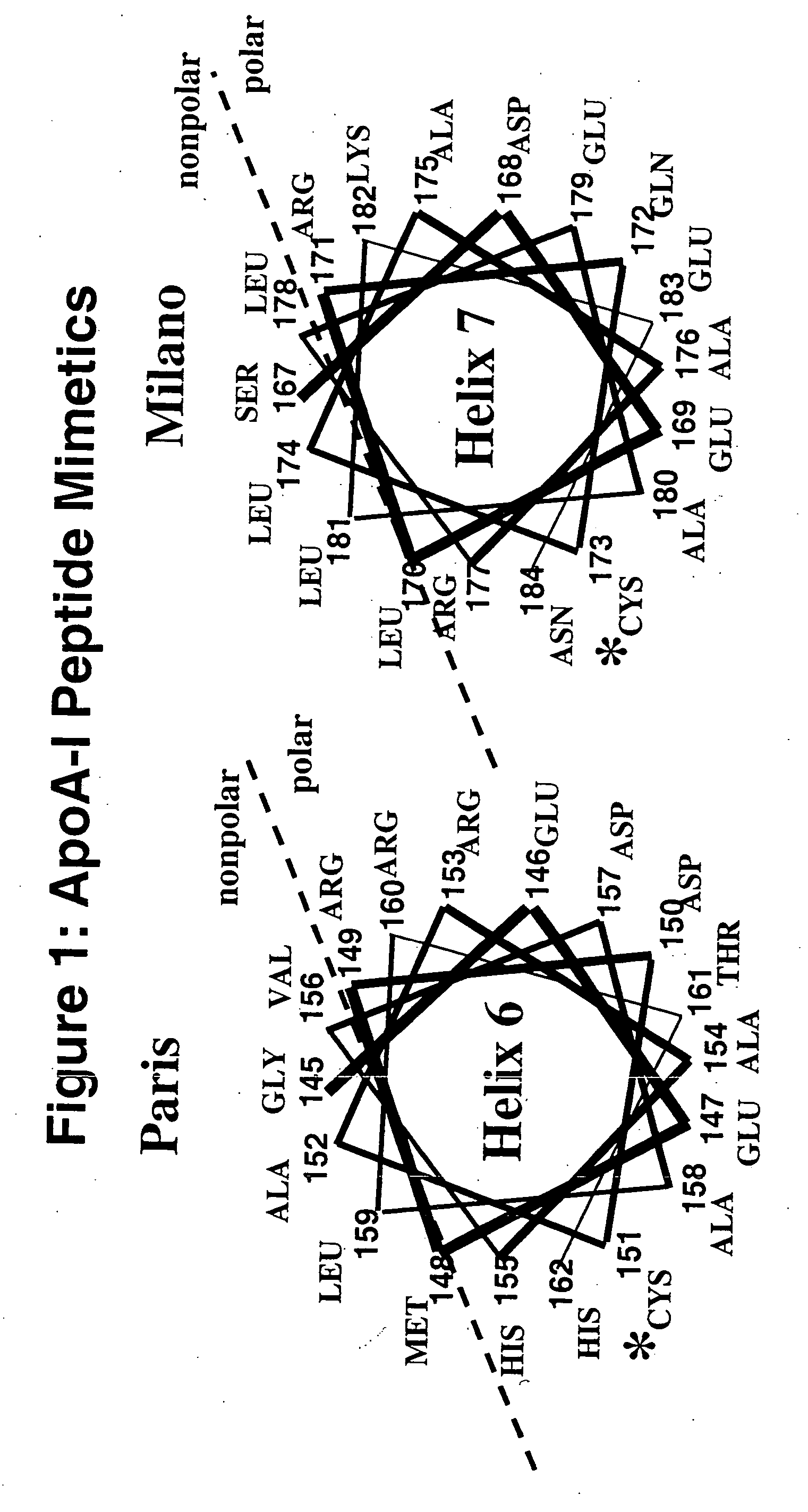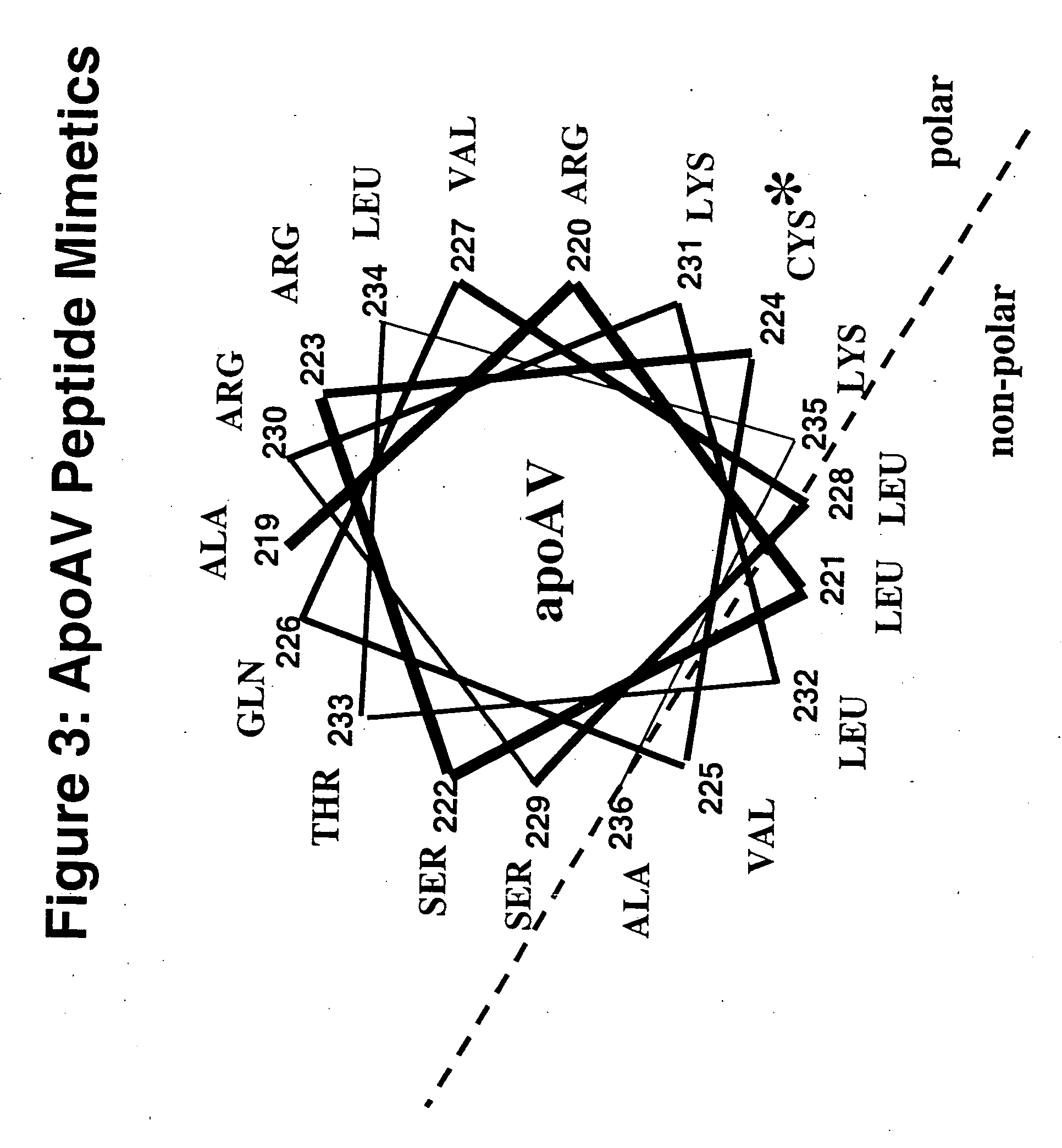Cysteine-containing peptides having antioxidant properties
a technology of cysteine-containing peptides and antioxidant properties, which is applied in the field of human lipid metabolism, can solve the problems of incomplete understanding of the mechanism(s) by which apoa-isub>milano /sub>and apoa-isub>paris /sub>exert anti-atherogenic effects, and achieves potent antioxidant activity, blocking phospholipid oxidation, and new antioxidant activity.
- Summary
- Abstract
- Description
- Claims
- Application Information
AI Technical Summary
Benefits of technology
Problems solved by technology
Method used
Image
Examples
example 1
[0093] Preparation of Synthetic Peptide Mimetics
[0094] Synthetic peptides were engineered from the monomeric forms of apoA-IMilano, apoA-IParis and apoE3. Peptides which lacked cysteine residues were developed from wild-type apoA-I and the apoE4 isoform and served as controls. All peptides were purchased from Biosynthesis Incorporated (Lewisville, Tex.) and were modified by an N-terminal acetyl group and C-terminal amide group. Peptides were dissolved in sterile, filtered, degassed 10 mM Tris-buffered (pH=8.0) Saline EDTA (2.7 mM) and stored at 4° C. The antioxidant activity of the thiol-containing peptides remained stable over a 3 month period when stored in this manner.
example 2
[0095] Micelle Substrate to Test the Antioxidant Activity of the Peptides
[0096] A schematic showing the assays used for determining the antioxidant activity of synthetic peptide mimetics is shown briefly at FIG. 4. Assays 1 and 2 utilize a micelle substrate composed of 1 mM 1-palmitoyl-2-linoleoylphosphatidylcholine dispersed in Borate (0.2 M) buffered (pH=9.0) / saline-EDTA (2.7 mM) containing deoxycholate. The buffer is made by adding 1.52 grams of deoxycholate to 50 ml of borate buffer / saline-EDTA. The phospholipid is dried on the surface of a glass tube and resuspended with borate / saline-EDTA / deoxycholate and vortexed to dissolve the lipid. The tube is incubated at 37° C. for 10 minutes and allowed to cool to 25° C. before use.
example 3
[0097] Assay to Test Perodixation of Phospholipids in Presence of Peptides
[0098] The oxidation system consisted of a micelle substrate composed of 1-palmitoyl-2-linoleoylphosphatidycholine (3 mM) dispersed in borate (pH=9.0) / saline-EDTA (2.7 mM) and deoxycholate (6 mM) as described. Phospholipid micelles were used throughout most of these studies to optimize rates of lipid peroxidation catalyzed by specific enzymes. This permitted us to quantify initial rates reliably and in reproducible fashion. Soybean lipoxygenase (5 U / μl) and xanthine (0.2 mM) / xanthine oxidase (20 U / ml) were used to initiate lipid peroxidation following the addition of recombinant apolipoproteins to the phospholipid micelles. Increases in conjugated dienes (lipid peroxidation) were monitored by ultraviolet absorption spectroscopy (234 nm) at 25° C. The mass of phospholipid hydroperoxides was calculated using the molar absorptivity coefficient (ε=29,500 Lcm−1 mol−1) of conjugated dienes. This is made possible be...
PUM
| Property | Measurement | Unit |
|---|---|---|
| concentration | aaaaa | aaaaa |
| concentrations | aaaaa | aaaaa |
| concentrations | aaaaa | aaaaa |
Abstract
Description
Claims
Application Information
 Login to View More
Login to View More - R&D
- Intellectual Property
- Life Sciences
- Materials
- Tech Scout
- Unparalleled Data Quality
- Higher Quality Content
- 60% Fewer Hallucinations
Browse by: Latest US Patents, China's latest patents, Technical Efficacy Thesaurus, Application Domain, Technology Topic, Popular Technical Reports.
© 2025 PatSnap. All rights reserved.Legal|Privacy policy|Modern Slavery Act Transparency Statement|Sitemap|About US| Contact US: help@patsnap.com



